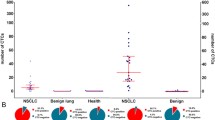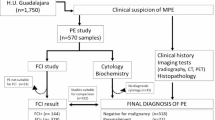Abstract
Purpose
To investigate the diagnostic and prognostic value of circulating tumor cells (CTCs), a potential surrogate of micrometastasis, in malignant pleural mesothelioma (MPM).
Methods
We prospectively evaluated CTCs in 7.5 mL of peripheral blood sampled from patients with a suspicion of MPM. A semiautomated system was used to capture CTCs with an antibody against the epithelial cell adhesion molecule.
Results
Of 136 eligible patients, 32 were finally diagnosed with nonmalignant diseases (NM), and 104 had MPM. CTCs were detected in 32.7 % (34 of 104) of MPM patients but in only 9.4 % (3 of 32) of NM patients (P = 0.011). The CTC count was significantly higher in MPM patients than in NM patients (P = 0.007), and a receiver operating characteristic (ROC) curve analysis showed an insufficient capability of the CTC test in discrimination between MPM and NM, with an area under ROC curve of 0.623 (95 % confidence interval, 0.523–0.723; P = 0.036). Among MPM patients, CTCs were more frequently detected in patients with epithelioid subtype (39.7 %, 31 of 78) than in those with nonepithelioid subtypes (11.5 %, 3 of 26; P = 0.016). Positive CTCs (CTC count ≥1) were a significant factor to predict a poor prognosis among epithelioid patients (median overall survival, 22.3 months for positive CTCs vs. 12.6 months for negative CTCs; P = 0.004) and not in nonepithelioid patients (P = 0.649). A multivariate analysis showed that positive CTCs were a significant and independent factor to predict a poor prognosis (hazard ratio, 2.904; 95 % confidence interval, 1.530–5.511; P = 0.001) for epithelioid MPM patients.
Conclusions
CTC was a promising marker in diagnosis and prediction of prognosis in MPM, especially in epithelioid MPM.




Similar content being viewed by others
References
Ismail-Khan R, Robinson LA, Williams CC, Garrett CR, Bepler G, Siomn G. Malignant pleural mesothelioma: a comprehensive review. Cancer Control. 2006;13:255–63.
Tsiouris A, Walesby RK. Malignant pleural mesothelioma: current concepts in treatment. Nat Clin Pract Oncol. 2007;4:344–52.
Scherpereel A, Astoul P, Baas P, et al. Guidelines of the European Respiratory Society and the European Society of Thoracic Surgeons for the management of malignant pleural mesothelioma. Eur Respir J. 2009;35:479–95.
Stahel RA, Weder W, Lievens Y, Felip E. Malignant pleural mesothelioma: ESMO clinical practice guidelines for diagnosis, treatment and follow-up. Ann Oncol. 2000;21(Suppl5):v126–8.
van der Bij S, Schaake E, Koffijberg H, Burgers JA, de Mol BAJM, Moons KGM. Markers for the non-invasive diagnosis of mesothelioma: a systematic review. Br J Cancer. 2011;104:1325–33.
Lee AY, Raz DJ, He B, Jablons DM. Update on the molecular biology of malignant pleural mesothelioma. Cancer. 2007;109:1454–61.
Sculier JP, Berghmans T, Meert AP. Update in lung cancer and mesothelioma. Am J Respir Crit Care Med. 2010;181:773–81.
Cao CQ, Yan TD, Bannon PG, McCaughan BC. A systemic review of extrapleural pneumonectomy for malignant pleural mesothelioma. J Thorac Oncol. 2010;5:1692–703.
Vogelzang NJ, Rusthoven JJ, Symanowski J, et al. Phase III study of pemetrexed in combination with cisplatin versus cisplatin alone in patients with malignant pleural mesothelioma. J Clin Oncol. 2003;21:2636–44.
Ray M, Kindler HL. Malignant pleural mesothelioma: an update on biomarkers and treatment. Chest. 2009;136:888–96.
Allard WJ, Matera J, Miller MC, et al. Tumor cells circulate in the peripheral blood of all major carcinomas but not in healthy subjects or patients with nonmalignant diseases. Clin Cancer Res. 2004;10:6897–904.
Riethdort S, Fritsche H, Muller V, et al. Detection of circulating tumor cells in peripheral blood of patients with metastatic breast cancer: a validation study of the cell search system. Clin Cancer Res. 2007;13:920–8.
Cristofanilli M, Budd GT, Ellis MJ, et al. Circulating tumor cells, disease progression, and survival in metastatic breast cancer. N Engl J Med. 2004;351:781–91.
Cristofanilli M, Hayes DF, Budd GT, et al. Circulating tumor cells: a novel prognostic factor for newly diagnosed metastatic breast cancer. J Clin Oncol. 2005;23:1420–30.
Cohen SJ, Punt CJ, Iannotti N, et al. Prognostic significance of circulating tumor cells in patients with metastatic colorectal cancer. Ann Oncol. 2009;20:1223–9.
Sastre J, Maestro ML, Puente J, et al. Circulating tumor cells in colorectal cancer: correlation with clinical and pathological variables. Ann Oncol. 2008;19:935–8.
Tanaka F, Yoneda K, Kondo N, et al. Circulating tumor cell as a diagnostic marker in primary lung cancer. Clin Cancer Res. 2009;15:6980–6.
de Bono JS, Scher HI, Montgomery RB, et al. Circulating tumor cells predict survival benefit from treatment in metastatic castration-resistant prostate cancer. Clin Cancer Res. 2008;14:6302–9.
Naoe M, Ogawa Y, Morita J, et al. Detection of circulating urothelial cancer cells in the blood using the CellSearch system. Cancer. 2007;109:1439–45.
Hiraiwa K, Takeuchi H, Hasegawa H, et al. Clinical significance of circulating tumor cells in blood from patients with gastrointestinal cancer. Ann Surg Oncol. 2008;15:3092–100.
Rusch VW. A proposed new international TNM staging system for malignant pleural mesothelioma from the international mesothelioma interest group. Lung Cancer. 1996;14;1–12.
Hanley JA, McNeil BJ. The meaning and the use of the area under a receiver operating characteristic (ROC) curve. Radiology. 1982;143:29–36.
Nagrath S, Sequist LV, Maheswaran S, et al. Isolation of rare circulating tumour cells in cancer patients by microchip technology. Nature. 2007;450:1235–39.
Yoneda K, Tanaka F, Hashimoto M, et al. Circulating tumor cells (CTCs) and endothelial cells (CECs) in the diagnosis of malignant pleural mesothelioma (MPM): a single-institutional prospective study. American Society of Clinical Oncology 45th Annual Meeting (ASCO2009) 2009.6 Chicago.
Curren D, Sahmound T, Therasse P, van Meerbeeck J, Postmus PE, Giaccone G. Prognostic factors in patients with pleural mesothelioma: the European Organization for Research and Treatment of Cancer experience. J Clin Oncol. 1998;16:145–52.
Fennell DA, Parmer A, Shamash J, et al. Statistical validation of the EORTC prognostic model for malignant pleural mesothelioma based on three consecutive phase II studies. J Clin Oncol. 2005;23:184–9.
Acknowledgment
We thank Ms. Mayo Yamamoto for assistance in preparation of the manuscript. This study was supported by “The Special Coordination Funds for Promoting Science and Technology from the Japanese Ministry of Education, Culture, Sports, Science, and Technology,” “Grants-in-Aid for Scientific Research (KAKENHI B 24390335) from the Japan Society for the Promotion of Science (JSPS),” and “UOEH Grant for Advanced Research (H24-1) from University of Occupational and Educational Health, Japan.”
Author information
Authors and Affiliations
Corresponding author
Rights and permissions
About this article
Cite this article
Yoneda, K., Tanaka, F., Kondo, N. et al. Circulating Tumor Cells (CTCs) in Malignant Pleural Mesothelioma (MPM). Ann Surg Oncol 21 (Suppl 4), 472–480 (2014). https://doi.org/10.1245/s10434-013-3399-2
Received:
Published:
Issue Date:
DOI: https://doi.org/10.1245/s10434-013-3399-2





